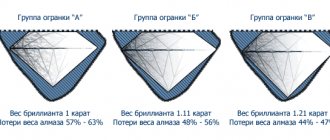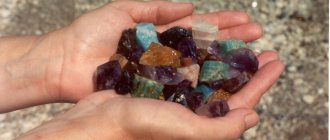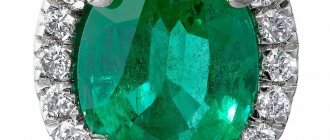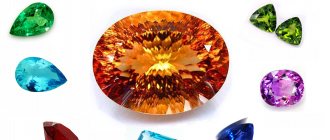The Baguette cut resembles a rectangle in shape, consisting of several steps. There are different types of baguette cuts: rectangular, square and trapezoidal. Most often, the baguette cut is used for small stones. In jewelry they are rarely used on their own; they are often combined with other diamonds - used as a frame or lined up.
View all jewelry with baguette-cut stones in the SUNLIGHT catalog
An insidious molding will reveal all the defects of the stone. They will be visible to the naked eye; a magnifying glass or microscope is not needed for this. Just look closely at the stone and you will see if it has any defects. When buying jewelry with stones processed in the shape of “Baguette” in a salon, you should pay special attention to their quality.
The main elements of a step cut in the “Baguette” shape
The main elements of a step cut in the “Baguette” shape
The cut has the shape of a rectangle, the type of cut is step. The classic faceted stone has 33 facets. The general form consists of a platform surrounded by 3 tiers of trapezoidal crown edges (4 edges per tier) and 4 tiers of trapezoidal pavilion edges (4 edges per tier).
View the “FANCY” jewelry collection in the SUNLIGHT catalog
Princess
The “princess” is characterized by an unusual play of light in the stone, but it is made in a square or rectangular shape. First appeared in 1960-1970. The cost of such a stone is less, since during cutting it practically does not lose weight. Diamonds are cut into princess shapes to decorate engagement rings. When placing a stone in a setting, try to close right angles, since they are the most fragile.
History of the Baguette cut
The Baguette cut variety appeared in the 1920s and 1930s, during the period of the spread of Art Deco and Art Nouveau styles. “Baguette” immediately became very popular thanks to its simple lines and stylish geometric shape, which was very different from the traditional ones. When making baguettes, fewer cuts are required than in other cuts, but this type is only suitable for stones of exceptional purity, otherwise even the smallest flaws will be visible.
It was in the 20th century that the term "Baguette" was first used in English to refer to this popular form of stone as we know it today. Some believe that this cut was named after the long, thin loaf of French bread that it often resembles.
See all jewelry with emerald in the SUNLIGHT catalog
Marquis
This type of gemstone processing was named after the Marquise de Pompadour, the favorite of King Louis XV. The world-famous beauty's flirtatious smile was immortalized in an oval-cut jewel with elongated, pointed tips. The shape of stones processed in this way is more like a boat.
Marquise-cut stones are very fragile: their elongated tips can easily be broken, so such jewelry is worn very carefully.
Antique Baguette Cut Jewelry
One of the most famous baguette-cut jewelry is the elegant “Basket” diamond brooch. The gold brooch is decorated with natural diamonds and sapphires. A total of 115 diamonds and 7 baguette-cut blue sapphires are set into the brooch in the form of a track. Presumably the decoration was made in Western Europe in the second third of the 20th century.
Diamond brooch “Basket” with sapphires in the shape of “Baguette”
The luxurious wedding of Grace Kelly and the Prince of Monaco lasted two days. So, on April 18, 1956, a closed event was held only for loved ones, and the next day there was a solemn wedding, which everyone could watch. At the private reception, Grace wore these stunning platinum jewelry. Bains de Mer tiara with baguette-cut diamonds and three ruby cabochons. And the total weight of the stones in the diamond necklace was 58 carats.
Bains de Mer tiara and baguette-cut diamond necklace
The pearl set is Rainier's wedding gift. The set from Van Cleef & Arpels consists of a necklace and bracelet, as well as stud earrings and a cocktail ring with a pear-shaped pearl. By the way, this particular jewelry house was the official supplier of jewelry for the princely couple of Monaco. Kelly loved wearing these pieces to many events. Today the set is part of the Monaco Dynasty Jewelry Collection.
Van Cleef & Arpels set with baguette-cut diamonds
Operating technique
The first jewelers processed precious stones only by grinding. They cut off excess parts from the mineral and achieved a smooth surface. This technique was called "Cabochon". Nowadays, stones of matte opaque shades are cut this way - turquoise, howlite, turquenite. The result is a crystal in which one surface is flat and the other is convex.
Facet cutting is used for stones that transmit light. The sun's rays hit the mineral, refract on its edges and cause a sparkling shine. In total, there are several processing schemes :
- wedge;
- faceted;
- Russian;
- combined.
With a wedge cut, the stone reflects light best. Jewelers use this scheme to give luxurious shapes to diamonds, rock crystal, rubies, topazes and emeralds. Facet or step processing allows you to reveal the inner beauty of the stone. The height of the cut depends on the color of the mineral: the darker it is, the greater the number of facets. The technique is suitable for sapphires, hyacinths and rubies.
The Russian scheme involves the ruthless removal of all parts of the gem that interfere with giving it a symmetrical shape. Used exclusively for diamonds. The combined type combines the techniques of all three types of cutting. Jewelers obtain the most beautiful and expensive stones using mixed cutting.
Modern masters of jewelry art do not stop at the achieved results. They are constantly in search of new stone processing techniques. After all, you can create a unique piece of jewelry with a beautiful gem only using imagination, knowledge and skills.
Wedding rings with baguette cut stone
During the Art Deco era, many engagement rings were created with baguette-cut stones. An example would be a ring with six baguettes and eighteen round diamonds surrounding a 1.37 carat emerald cut diamond. The use of geometric shapes is a defining characteristic of this period.
Art Deco wedding ring, circa 1930s
Another Art Deco treasure is the engagement ring, which features a 2.40-carat emerald-cut center stone, 0.85-carat baguettes and triangular diamonds, and 0.96-carat triangular synthetic rubies.
Art Deco style engagement ring with 2.40 carat center stone
The baguette cut is often used to create modern jewelry and engagement rings. So if you're looking for a modern version of an Art Deco engagement ring, consider a baguette-shaped stone.
View a white gold ring with baguette-cut diamonds in the SUNLIGHT catalog
Baguette cut diamonds bring elegance with a hint of understatement wherever they are used. However, there are other small diamonds that are worth considering as options - especially if you want to add drama and sparkle to your engagement ring. Introducing small diamonds weighing up to 0.90 carats, which, despite their size, make a huge impression.
View the “IN COLOR” jewelry collection in the SUNLIGHT catalog
Cabochon
The most ancient type of cutting of precious stones, in which the mineral is given a convex shape without facets. Typically, this type of processing is used for cutting opaque or translucent inserts and minerals with a “cat’s eye” effect. The quality of polishing and grinding of the stone plays a huge role, since the main requirement for cabochons is a perfectly smooth surface.
Baguette-cut diamond: What you need to pay attention to
This section contains important points that you need to pay attention to when purchasing a baguette cut diamond. The following are some tips on how to choose a beautiful baguette cut diamond:
- Baguettes that rank higher on the diamond color scale from D to Z are the most valued.
- All baguettes in one ring should be of similar shade and clarity and match the center diamond. A baguette-cut diamond whose color or clarity differs markedly from another similar one or from the center stone is likely to give the impression of disharmony.
- A step cut means that the edges should be parallel to the flat edges. Even small deviations in the symmetry of the edges are usually noticeable to the naked eye and do not look good with the stone. Make sure all edges are parallel and symmetrical.
- Avoid inclusions - they tend to be more noticeable on a baguette cut diamond than on a round brilliant cut diamond.
- Baguettes are usually bought in sets. For the “accent” stones on the ring overlay, you will most likely need one, two or three baguettes and tapered baguettes on each side of the center. They will need to match each other in length and width so that they can be secured symmetrically.
View the white gold pendant with baguette-cut diamonds in the SUNLIGHT catalog
Trillion
The most spectacular cut of precious stones. The shape resembles a triangle with wedges. Depending on the design of the finished jewelry, the characteristics of the gem and the imagination and skill of the jeweler, the number of facets and the shape of the stone can change, which is an advantage of the trillion. This type of cut was first invented in Amsterdam, and today it is the most popular in the world.
Radiant
Externally, a stone that has been given such a cut looks like a square or rectangle with cut corners. Radiant combines the features of such cuts as “emerald” and “princess”. Jewelers use it for minerals that must be shown in all their glory: the play of light, color, purity, transparency and size of the stone are demonstrated with this treatment. This cut has a more masculine and brutal character, so it is often chosen to create men’s jewelry. Visually, such products shorten the phalanges of the fingers.











